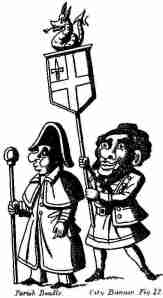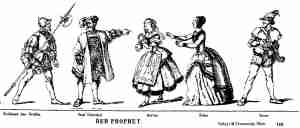
Joseph Parks of Saltburn-on-Sea published the magazine “Vanity fair” from 1917 to 1927. It then became the “Collector’s Miscellany” from 1928 until 1953. It was a publication for collectors of all sorts of things, including Toy Theatre. It had articles by George Speaight and others. The information is not always accurate but it has period interest and some of it does not appear elsewhere. A lot of the issues have been scanned and can be viewed for free on http://www.friardale.co.uk.
The following is a list of the main items related to Toy Theatre that appear in the issues currently available:
VANITY FAIR
Vol.2 issue 16, November 1925. “March’s Theatre”, Frank Jay.
Vol.2 issue 18, January 1926, “March’s Mother Goose”, Edward Herdman.
Vol.3 issue 28, December 1926, Daily mirror photo of Benjamin Pollock in his shop.
COLLECTOR’S MISCELLANY
Vol.1 issue 6. February 1929. “Juvenile Theatre its History and Development” part2. Frank Jay.
Vol.1 April-May 1932, Letter “Juvenile Drama”, FS
New series:
No.1 November-December 1932. “Plays in Packets” , E.Percival.
No.7 December-January 1933/4 “Juvenile Theatre”, M.W.Stone.
No.8 February-April 1934 “W.West 1811-1831”, M.W.Stone.
No.9. May-September 1934 “The Plays of Hodgson 1822-1834”, M.W.Stone.
No.10 March 1935 “J.K.Green (1808?) 1811”, M.W.Stone.
No.13 October 1935 “Price of sheets 1811-1935”, G.Speaight.
No.14 December 1935 “Juvenile Theatre”, Gerald Morice.
No.15 August 1936 “Practical performances on the Toy Theatre”, G.Speaight.
No.16 October 1936 “The Juvenile Drama Abroad”, Gerald Morice.
No.17 December 1936 ditto part 2.
No.18 February-May 1937. Front cover shows first page of the first issue (1870) of the “Boy’s Halfpenny Weekly Budget of Plays, Stories, Characters and Scenes”, which included 2 free plates of “Timour the Tartar”.
No.22 August-December 1938 “The Toy Theatre”, Gerald Morice.
No.24.January-June 1939 “Side Lines of Toy Theatre Publishers”, G.Speaight.
Fourth series:
No.2 Winter 1941 “Same scene but different play” , Charles Williams
No.3. February 1942 “About Webb’s Plays”, Charles Williams.
No.4. July 1942 “Some Mathew Revivals”, Charles Williams.
No.5. Undated. “Revivals of Andrews & Co.”, Charles Williams.







